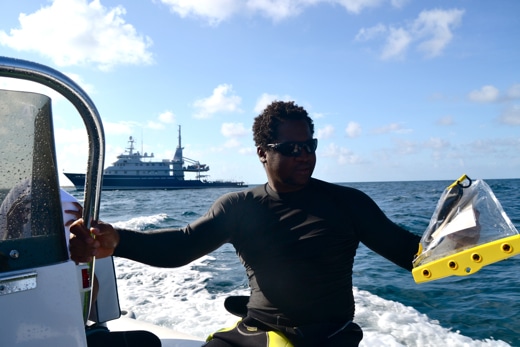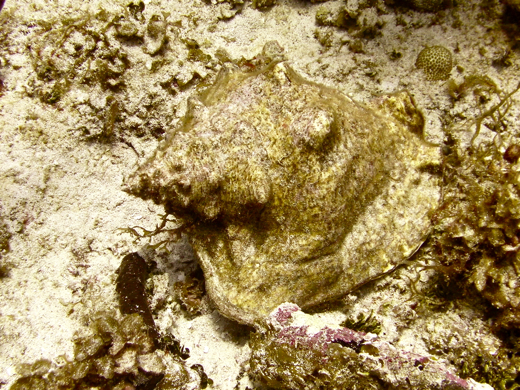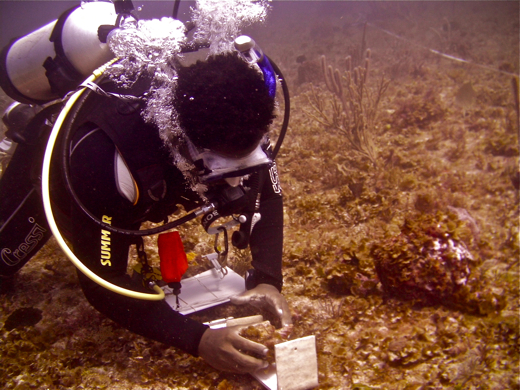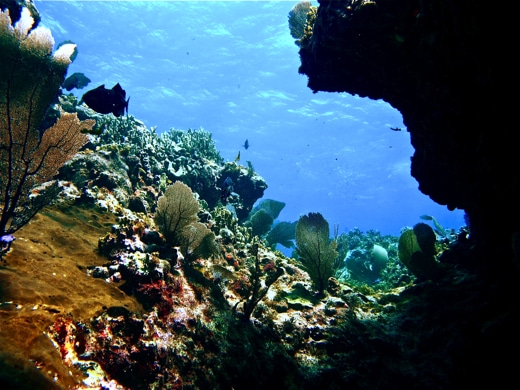Each day, as the bulk of the team’s divers head out to the reefs aboard the Calcutta, a group of four divers from Colombia hops in a smaller boat to go looking for queen conch. It’s a continuation of work that’s been underway since 2003 to study conch populations in the archipelago here.

That was when the Colombian government first closed their conch fishery, except for limited collections by those with special licenses for subsistence fishing. They took this drastic step because the conch populations had plummeted, especially around the archipelago’s inhabited islands, San Andres, Old Providence, and Santa Catalina, about 250 kilometers south of us.
You can find queen conch in at least 36 countries, and they’ve been so overfished in many places that the species is now listed as a threatened fishery on Appendix II for the Convention on International Trade in Endangered Species.

The entire San Andrés archipelago is part of the massive 300,000 square kilometer Seaflower Biosphere Reserve, fully 10 percent of the Caribbean Sea. A large chunk of the southern portion of this area is a marine protected area where not just conch but other types of fishing are also restricted.
Several team members are from San Andrés and Providence and work for the Corporation for the Sustainable Development of the Archipelago of San Andrés, Old Providence and Santa Catalina, or CORALINA. This is a sort of hybrid between a government agency and a non-profit organization that is responsible for the region’s environmental planning, management and research. CORALINA is doing the conch research in cooperation with the Government Department of Agriculture and Fisheries, and we have a representative from that agency aboard as well.

Back in 2003, these groups started surveying conch at three remote banks we won’t be visiting, Quitasueño, Serrana and Rancador (Northern MPA), which are midway between here and San Andrés. After finding very few conch, Colombia closed the fishery for that region. They reopened it in 2007 but populations dropped so quickly they had to close it again in 2010 and have seen increases. Around the inhabited islands, though, it’s still difficult to find any adult conchs. So, the researchers have been transplanting thousands of conchs from Serrana to Old Providence waters in hopes of eventually rebuilding those populations.
A couple of years ago these researchers also started working in the even more remote banks where our expedition team has been diving. When the conch team heads out, they are revisiting spots that they also looked at during expedition in 2010 where they got baseline data that led to closing conch fishing in this area as well. At each site their work involves laying down four 30-meter-long transect lines, then counting and measuring the size of the conchs four meters to either side of those lines.

The conchs are more common in flatter areas, so the scenery usually isn’t as spectacular as the reefs where the rest of the team works. But, it’s usually the conch team that dolphins drop in to check on from time to time. Today one appeared out of the murk, made a pass, circled back and then was gone. A few days back it was a group of 10 dolphins.
Out here, since 2010 they’ve seen populations that are roughly flat. Hard to know without further work why that might be if populations are increasing elsewhere. But of the few fishing boats we’ve seen, at least two of them were diving illegally for conch, and we’ve found piles of cleaned conch shells.

While the conch team was running their transects today, the reef dive team was having its best day yet at Serranilla. After analyzing satellite imagery they found extensive reef patches in the middle of the bank with lots of coral and good diversity. They spotted two species they hadn’t seen yet in Serranilla, and a couple—rough cactus coral and thin leaf lettuce coral—that we hadn’t spotted at all yet during the mission. We also saw more lobsters than anywhere else and the fish folk were happy to find good diversity as well, including the first large schools of grunts and more snapper than at the other banks.
The results of all this mission’s conch and reef research will feed into continuing efforts by the Colombians to develop more effective conservation plans for this unique region.
(Photos/Images by: 1-4 Mark Schrope, 5 Brian Beck)
To follow along and see more photos, please visit us on Facebook! You can also follow the expedition on our Global Reef Expedition page, where there is more information about our research and team members.